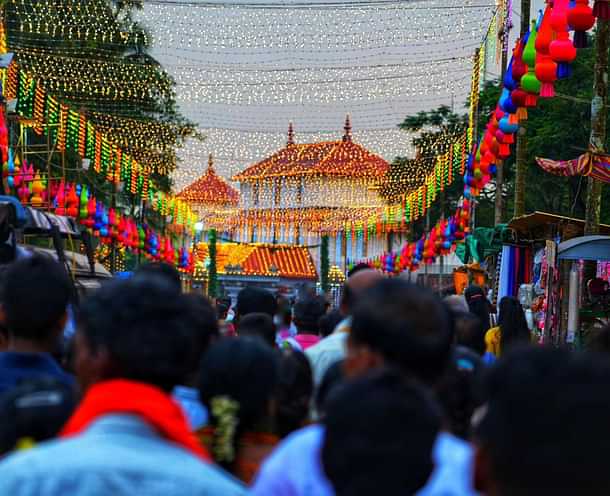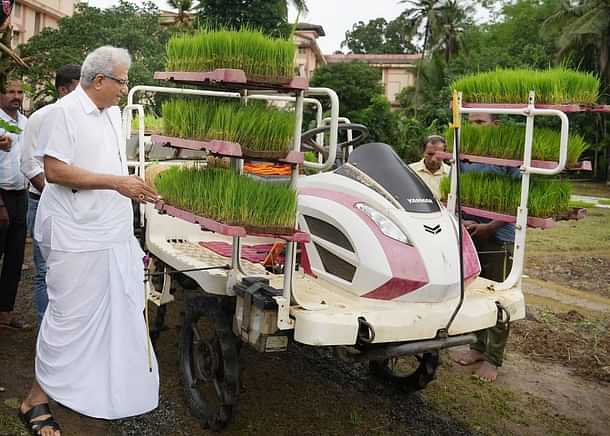Culture
Dharmasthala: A Model for Private Management Amid Calls to 'Free Hindu Temples'
Sharan Setty
Nov 13, 2024, 01:45 PM | Updated 02:07 PM IST
Save & read from anywhere!
Bookmark stories for easy access on any device or the Swarajya app.


Tucked between the two strategic roads — Shiradi and Charmady — in the Western Ghats of Karnataka, Dharmasthala is the abode of dharma, Sri Kshetra Manjunatha Swamy temple.
The temple has been a holy place for Hindus for 600 years when it was first established by the Pergades (now known as Heggades), a Jain family that built a Shiva temple. It is located about 70 kilometres from the coastal city of Mangaluru, the headquarters of the Dakshina Kannada district.
Surrounded by thick forests, streams and hills, the temple is visited by millions of pilgrims who seek Manjunatha's blessings. It is one among the handful of big Hindu temples which are privately run. Successive governments have tried to bring it under their control, eyeing influence and wealth, but have faced opposition both from the trust and the devotees.

Dharmasthala has not just an example for the rest of the country, but a proven record of inclusive governance, charitable work and a template for peaceful co-existence, harmony and devotion to the gods.
Hindus and Jains have co-existed and promoted each other's religion and traditions for centuries. The temple is known for its chaturdaanas (charities) — annadaana, aushadadaana, vidyadaana and abhayadaana (food, medicine, education and security).
The head of the temple, presently Dr Veerendra Heggade, oversees the charitable work and the administration of the temple. He is known as the dharmadhikari — the voice of Sri Manjunatha Swamy. Before him, twenty generations of the Heggade lineage have devoted their lives to the development of the temple and its various activities.

Although the temple has been founded by a Jain family, it is dedicated to Shiva. The rituals are performed by Vaishnavite Brahmin priests who worship Vishnu. Shri Chandranatha Swamy Basadi, named after a Jain Tirthankara, is also located here. Both are worshipped here.
In Dharmasthala: The Mantra of Development, author and journalist Nagesh Prabhu describes how the temple has come to be an inspiration for Hindus across the world, as it is not just the cleanest temple town, but has also earned praise for its transparency in governance and having a keen ear to the ground in terms of receiving feedback and making themselves flexible to the devotees' demands.

According to Heggade, a strong rural society, empowered through education, is the true hallmark of growth. This is also complemented by social justice, economic equality and education. This is one of the reasons why the temple trust runs more than a hundred institutions across the state, including the Shri Kshetra Dharmasthala Rural Development Project (SKDRDP) and the Rural Development and Self Employment Training Institute (RUDSETI).
Heggade was also recently nominated to the Rajya Sabha for his philanthropic work and for playing an important role as a cultural ambassador from the south who is unapologetically spreading dharma. All this is possible to a large extent because there is no external authority imposing impossible rules in the name of governance.

“Every temple has its own culture, own tradition, its parampara. There is no question of the government intervening especially in the customs and traditions of any place. Wherever you see government intervention, you see a lot of confusion because it may be more democratic but it doesn’t serve the purpose", Dr Heggade believes.
According to him, a democratic institution can exist, but "you cannot have a democratic house". Similarly, for the rituals in temples, he believes that the interference of the state in religious and spiritual activities may not be in good taste.
Free meals are provided to devotees visiting Dharmasthala twice a day in the Annapoorna dining hall. During festival season, more than a lakh dine on a single day, making it a humongous operation by itself. Apart from annadaana, educational institutes, and medical facilities help thousands of people in the state get access to free and affordable healthcare and education.

Compare this to a government-run temple where the decision-making process is slow, and in the name of 'inclusion', nefarious activities are taking place. A recent controversy that erupted in Tirupati may have something to tell us about the advantages of privately running government temples. There's also transparency on the temple resources, as charitable work requires capital, and the revenue generated through different means is used for building good social capital which also keeps the community bound.
Regardless of one's profession and personal beliefs, devotees throng the temple before important life events. The temple is known for visits from prominent political personalities and scientists alike, who pray for success from time to time.
Dharmasthala has also patronised arts, culture and literature. Shivaram Karanth, the famous Kannada writer, has been inspired by the temple and its surroundings. Annual sarvadharma sammelana (multi-religious meet) and sahitya sammelanas are organised during the five-day Lakshadeepotsava in Dharmasthala.

Yakshagana performances are also encouraged, where the local culture is embodied in the music, dance, mime meets theatre arrangement. This troupe has been active since the last two hundred years. It is not uncommon for the temple management to organise mass marriages and de-addiction drives to promote the well-being and welfare of the Hindu society.
Dharmasthala, despite the devotees rushing in millions, has maintained health, hygiene and cleanliness. India Today declared the town as the cleanest religious town in 2016.
There's a state-of-the-art sewage treatment plant that converts waste into manure for agricultural purposes. Sri Dharmasthala Manjunatheswara Dharmothana (SDMD) Trust has also helped restore more than 200 temples, small and big.

As debates around freeing Hindu temples from government control continue, the Dharmasthala model offers a template for how temples can thrive under private administration. The success of Dharmasthala is rooted in the Heggades' commitment to inclusivity, transparency, and societal welfare, demonstrating that temples can play a pivotal role in nation-building when managed by dedicated and accountable individuals.
Private temple administration, when done with a sense of duty and devotion, can ensure that temples remain vibrant centres of spiritual and social growth. Dharmasthala’s success is a testament to how temples, free from state control, can become powerful forces for good, contributing not just to religious life but to the overall well-being of society.
Sharan Setty (Sharan K A) is an Associate Editor at Swarajya. He tweets at @sharansetty2.





